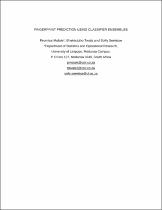JavaScript is disabled for your browser. Some features of this site may not work without it.
- ResearchSpace
- →
- Research Publications/Outputs
- →
- Conference Publications
- →
- View Item
| dc.contributor.author |
Molale, P

|
|
| dc.contributor.author |
Twala, B

|
|
| dc.contributor.author |
Seeletse, S

|
|
| dc.date.accessioned | 2011-12-09T11:36:58Z | |
| dc.date.available | 2011-12-09T11:36:58Z | |
| dc.date.issued | 2011-11 | |
| dc.identifier.citation | Molale, P, Twala, B and Seeletse, S. 2011. Fingerprint prediction using classifier ensembles. 53rd Annual Conference of the South African Statistical Association for 2011 (SASA 2011), CSIR, CSIR Convention Centre, Pretoria, South Africa, 1-3 November 2011 | en_US |
| dc.identifier.uri | http://hdl.handle.net/10204/5379 | |
| dc.description | 53rd Annual Conference of the South African Statistical Association for 2011 (SASA 2011), CSIR, CSIR Convention Centre, Pretoria, South Africa, 1-3 November 2011 | en_US |
| dc.description.abstract | In this study, the application of classifiers to problems in fingerprint prediction is investigated. Six supervised learning and two statistical fingerprint classification methods (classifiers) are considered: linear discriminant analysis (LDA); logistic discrimination (LgD), k-nearest neighbour (k-NN), artificial neural network (ANN), association rules (AR) decision tree (DT), naive Bayes classifier (NBC) and the support vector machine (SVM). The performance of several multiple classifier systems are also demonstrated and evaluated in terms of their ability to correctly predicting or classifying a fingerprint using the National Institute of Standards and Technology (NIST) biometric image database. Examining the performance of the base classifiers showed DT, SVM and ANN to have the highest accuracy while LDA has the lowest accuracy rate. The results further show all the multi stage systems to significantly outperform the baseline classifiers. Accordingly, good performance is consistently derived from boosting. | en_US |
| dc.language.iso | en | en_US |
| dc.publisher | South African Statistical Association for 2011 | en_US |
| dc.relation.ispartofseries | Workflow request;7616 | |
| dc.subject | Fingerprints | en_US |
| dc.subject | Classifier ensembles | en_US |
| dc.subject | Machine learning | en_US |
| dc.subject | Fingerprint prediction | en_US |
| dc.subject | Artificial neural network | en_US |
| dc.subject | SASA 2011 | en_US |
| dc.title | Fingerprint prediction using classifier ensembles | en_US |
| dc.type | Conference Presentation | en_US |
| dc.identifier.apacitation | Molale, P., Twala, B., & Seeletse, S. (2011). Fingerprint prediction using classifier ensembles. South African Statistical Association for 2011. http://hdl.handle.net/10204/5379 | en_ZA |
| dc.identifier.chicagocitation | Molale, P, B Twala, and S Seeletse. "Fingerprint prediction using classifier ensembles." (2011): http://hdl.handle.net/10204/5379 | en_ZA |
| dc.identifier.vancouvercitation | Molale P, Twala B, Seeletse S, Fingerprint prediction using classifier ensembles; South African Statistical Association for 2011; 2011. http://hdl.handle.net/10204/5379 . | en_ZA |
| dc.identifier.ris | TY - Conference Presentation AU - Molale, P AU - Twala, B AU - Seeletse, S AB - In this study, the application of classifiers to problems in fingerprint prediction is investigated. Six supervised learning and two statistical fingerprint classification methods (classifiers) are considered: linear discriminant analysis (LDA); logistic discrimination (LgD), k-nearest neighbour (k-NN), artificial neural network (ANN), association rules (AR) decision tree (DT), naive Bayes classifier (NBC) and the support vector machine (SVM). The performance of several multiple classifier systems are also demonstrated and evaluated in terms of their ability to correctly predicting or classifying a fingerprint using the National Institute of Standards and Technology (NIST) biometric image database. Examining the performance of the base classifiers showed DT, SVM and ANN to have the highest accuracy while LDA has the lowest accuracy rate. The results further show all the multi stage systems to significantly outperform the baseline classifiers. Accordingly, good performance is consistently derived from boosting. DA - 2011-11 DB - ResearchSpace DP - CSIR KW - Fingerprints KW - Classifier ensembles KW - Machine learning KW - Fingerprint prediction KW - Artificial neural network KW - SASA 2011 LK - https://researchspace.csir.co.za PY - 2011 T1 - Fingerprint prediction using classifier ensembles TI - Fingerprint prediction using classifier ensembles UR - http://hdl.handle.net/10204/5379 ER - | en_ZA |






